常用荧光探针小结
常见的荧光探针及其在活性氧检测中的应用

常见的荧光探针及其在活性氧检测中的应用作者:付艳华来源:《当代化工》2019年第02期摘 ;;;;;要:荧光探针具有高灵敏度、高活性,在物质成分测定及反应进程监测中得到了广泛的应用。
常见的荧光探针根据荧光团的不同可以分为香豆素类、氟硼荧染料、菁染料、萘酰亚胺类、荧光素和罗丹明类。
活性氧(Reactive Oxygen Species, ROS)与各种细胞过程有关,主要包括转录因子的激活、基因表达、细胞增殖和死亡。
由于活性氧的寿命短、活性高,且会与蛋白质、DNA、脂质膜等迅速反应,给其检测工作带来了困难。
荧光探针作为一种高灵敏度的检测方法,在活性氧的检测工作中起到了重要作用。
在介绍了不同荧光探针的基础上,着重对检测活性氧的荧光探针进行了详细的分类与描述。
关 ;键 ;词:活性氧;荧光探针;荧光团中图分类号:TQ422 ;;;;;;文献标识码: A ;;;;;;文章编号: 1671-0460(2019)02-0384-04Abstract: Fluorescent probes have high sensitivity and high activity, so they have been widely used in the monitoring of material composition and reaction process. Common fluorescence probes can be divided into coumarin, BODIPY, cyanine, naphthalimides, fluoresceins and rhodamines probes. Reactive oxygen species (ROS) are involved in various cell processes, including transcription factor activation, gene expression, cell proliferation and death. Due to the short life and high activity of reactive oxygen, it is easy to react with protein, DNA, lipid membrane and so on, so it is very difficult to detect ROS. As a high sensitive detection method, fluorescent probe plays an important role in the detection of ROS. In this paper, different fluorescent probes were introduced, especially the fluorescence probes for the detection of reactive oxygen species.Key words: Reactive oxygen species; Fluorescent probe; Fluorophore荧光是分子从激发单重态回到基态的过程中发射出的光,然而大多数的待测分子本身没有荧光特性,而且在化学反应的过程中,也很少能够发出荧光。
常见的小分子荧光探针种类
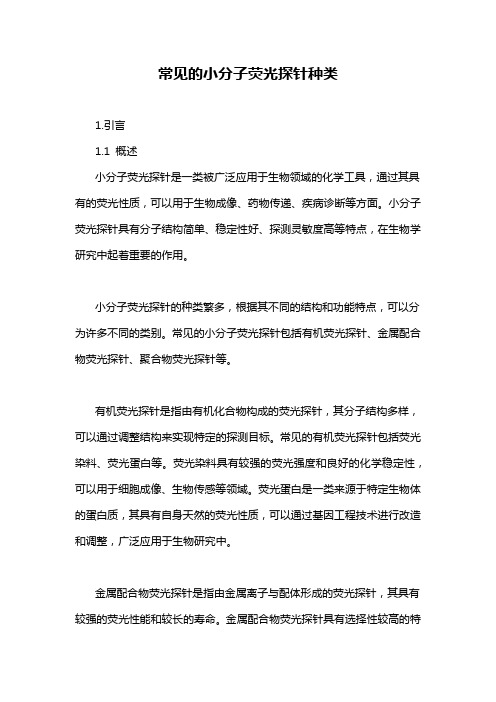
常见的小分子荧光探针种类1.引言1.1 概述小分子荧光探针是一类被广泛应用于生物领域的化学工具,通过其具有的荧光性质,可以用于生物成像、药物传递、疾病诊断等方面。
小分子荧光探针具有分子结构简单、稳定性好、探测灵敏度高等特点,在生物学研究中起着重要的作用。
小分子荧光探针的种类繁多,根据其不同的结构和功能特点,可以分为许多不同的类别。
常见的小分子荧光探针包括有机荧光探针、金属配合物荧光探针、聚合物荧光探针等。
有机荧光探针是指由有机化合物构成的荧光探针,其分子结构多样,可以通过调整结构来实现特定的探测目标。
常见的有机荧光探针包括荧光染料、荧光蛋白等。
荧光染料具有较强的荧光强度和良好的化学稳定性,可以用于细胞成像、生物传感等领域。
荧光蛋白是一类来源于特定生物体的蛋白质,其具有自身天然的荧光性质,可以通过基因工程技术进行改造和调整,广泛应用于生物研究中。
金属配合物荧光探针是指由金属离子与配体形成的荧光探针,其具有较强的荧光性能和较长的寿命。
金属配合物荧光探针具有选择性较高的特点,可以用于特定金属离子的探测和诊断。
常见的金属配合物荧光探针包括铜离子、锌离子、铁离子等的配合物。
聚合物荧光探针是指由高分子聚合物构成的荧光探针,其具有较好的溶解性和稳定性。
聚合物荧光探针可以通过调整聚合物的结构和链长来实现特定的探测需求。
常见的聚合物荧光探针包括聚合物分子探针、聚合物纳米探针等。
总之,常见的小分子荧光探针种类繁多,具有不同的结构和功能特点,可以根据具体的研究需求选择适合的荧光探针进行应用。
这些小分子荧光探针为生物学研究提供了有力的工具,有助于深入理解生命的基本过程和疾病的发生机制。
未来,随着技术的不断发展和突破,相信小分子荧光探针在生物领域的应用会得到更广泛的推广和应用。
1.2文章结构1.2 文章结构本文主要围绕"常见的小分子荧光探针种类"展开讨论。
文章分为引言、正文和结论三个部分。
在引言部分,将进行概述、文章结构和目的的介绍。
荧光探针的研究及应用

荧光探针的研究及应用随着科技的不断发展,荧光探针逐渐成为生命科学研究领域中不可缺少的重要工具。
荧光探针是一种能够发射出荧光信号的分子,在分子生物学、生物医学和化学生物学等领域中有着广泛的应用。
它们可以被用来研究细胞内的分子相互作用、识别生物分子、分析细胞功能,并可以在体内用作活体成像和药物筛选的工具。
本文将简要介绍荧光探针的基本原理、常见的荧光探针类型和其在生物学研究中的应用。
一、荧光探针的基本原理荧光探针的基本原理是荧光共振能量转移(FRET),其通过将荧光分子与生物分子(生物样品)耦合,使两者之间发生相互作用,从而产生能量转移。
FRET 能量转移是从能量接受者的激发态到另一个分子的荧光染料的发射态的一种非辐射性能量转移。
在FRET中,激发荧光染料的光子会被共振耦合到另一个染料的激发态,从而使其发出荧光光子。
这样,在激发荧光染料的时候,可以用荧光染料的荧光光子来检测另一个染料的存在和位置。
荧光探针对于荧光光子的发射特征和其它的生化参数是很敏感的,所以它们可以被用来探测各种细胞和分子。
二、常见的荧光探针类型1. 荧光染料:荧光染料是最常见的荧光探针类型之一,它们有着广泛的应用,可以被用来标记蛋白质、核酸等生物分子。
常见的荧光染料包括荧光素、草铵膦、偶氮染料等。
2. 荧光蛋白:荧光蛋白是一种具有自发荧光性质的蛋白质,其最早源自于水母Aequorea victoria。
荧光蛋白可以用来跟踪胞内或胞外的重要过程,如蛋白质、核酸合成、信号传递等。
3. 量子点:量子点是一种半导体纳米粒子,具有窄的发射光谱、强的光稳定性和较大的荧光量子产率。
这些特点使得量子点成为新一代高亮度及高灵敏度的荧光探针。
三、荧光探针在生物学研究中的应用荧光探针广泛地应用于细胞内信息传递、化学生物学、生物传感、药物筛选和临床诊断等方面。
以下为举几个常见的案例:1. 细胞内信息传递:荧光探针可被用于研究细胞内信号转导、磷酸化和蛋白质相互作用等过程。
分析化学中的荧光探针及其应用
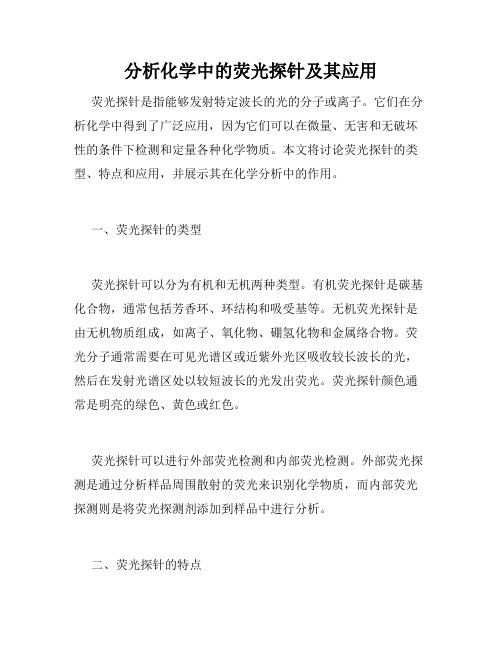
分析化学中的荧光探针及其应用荧光探针是指能够发射特定波长的光的分子或离子。
它们在分析化学中得到了广泛应用,因为它们可以在微量、无害和无破坏性的条件下检测和定量各种化学物质。
本文将讨论荧光探针的类型、特点和应用,并展示其在化学分析中的作用。
一、荧光探针的类型荧光探针可以分为有机和无机两种类型。
有机荧光探针是碳基化合物,通常包括芳香环、环结构和吸受基等。
无机荧光探针是由无机物质组成,如离子、氧化物、硼氢化物和金属络合物。
荧光分子通常需要在可见光谱区或近紫外光区吸收较长波长的光,然后在发射光谱区处以较短波长的光发出荧光。
荧光探针颜色通常是明亮的绿色、黄色或红色。
荧光探针可以进行外部荧光检测和内部荧光检测。
外部荧光探测是通过分析样品周围散射的荧光来识别化学物质,而内部荧光探测则是将荧光探测剂添加到样品中进行分析。
二、荧光探针的特点荧光探针具有以下特征:1. 显著的选择性。
一些荧光探针只与特定化学物质反应,这限制了潜在误报。
2. 极高的灵敏度和分辨率。
这些探针可以检测到非常微量的物质。
3. 高度可扩展性。
荧光探针可以被改变以适应特定的检测目标。
4. 可用于实时监测。
对于许多应用程序,荧光探针可以实时检测反应过程。
5. 无毒。
荧光探针不会对环境或生物组织造成损害。
三、荧光探针的应用由于荧光探针的独特性质和特点,使它被广泛应用于许多领域中,包括医学、生物学、环境科学、食品安全和纳米技术等。
1. 医学应用荧光探针已被用于实现药物的快速检测、药物溶出行为的研究、细胞成像、癌症治疗、诊断和疗效评估等医学领域。
例如,在肿瘤治疗中,荧光探针可用于检测肿瘤转移并诊断疾病。
在心血管疾病的研究中,荧光探针可用于检测低密度脂蛋白(LDL)和高密度脂蛋白(HDL)。
2. 生物学应用荧光探针已被广泛用于生物学领域,包括细胞成像、分子传感、蛋白质纯化和内部器官追踪等方面。
例如,在细胞成像中,荧光探针可以用来区分不同的细胞类型,并监测其活动。
荧光探针在生物分析中的应用

荧光探针在生物分析中的应用荧光探针作为一种重要的化学工具,在生物分析领域中得到了广泛应用。
其独特的荧光性质和分子识别能力使得荧光探针成为生物分析的理想选择。
本文将从荧光探针的原理、种类和在生物分析中的应用等方面进行探讨。
一、荧光探针的原理荧光探针是一种特殊的化学物质,其通过吸收外部能量后,能够发射特定波长的荧光。
荧光探针的原理基于分子的能级跃迁和荧光发射的过程。
当外界能量被注入到荧光探针分子中时,分子的电子会从基态跃迁到激发态。
在激发态停留一段时间后,电子会跃迁回基态并发射荧光。
荧光的强度和发射波长可用于分析和检测不同的物质。
二、常见的荧光探针种类1. 有机染料荧光探针:有机染料荧光探针是最早应用于生物分析的一类探针。
如常用的荧光标记剂FITC和Rhodamine B等,它们具有较好的荧光性能和化学稳定性,可用于细胞成像和蛋白质检测等。
2. 量子点荧光探针:量子点荧光探针是一种由半导体材料组成的纳米颗粒,具有尺寸可调、较窄的荧光发射光谱和较高的荧光量子产率等特点。
量子点荧光探针在细胞成像、癌症诊断等方面具有重要应用。
3. DNA探针:DNA探针是一类由DNA序列构成的荧光标记物,常用于基因检测、病毒检测等分子生物学研究。
通过合成具有特定序列的DNA探针,可以实现对特定基因序列的高选择性检测。
4. 蛋白质标记剂:荧光探针还可用于蛋白质的标记和鉴定。
通过将荧光探针与特定的抗体结合,可以实现对目标蛋白质在生物样品中的定量和定位检测。
三、荧光探针在生物分析中的应用1. 细胞成像:荧光探针可用于细胞内某种分子的动态观察。
通过将特定的荧光探针标记到目标分子上,如膜蛋白、胞质囊泡等,可以实现对细胞内生物过程的实时跟踪和定量分析。
2. 分子诊断:荧光探针在生物分子的检测和诊断中扮演着重要角色。
例如,通过荧光DNA探针可以实现基因突变的检测和药物靶点的鉴定,从而在疾病的早期诊断和治疗中起到关键作用。
3. 环境监测:荧光探针还可应用于环境监测。
荧光探针分类
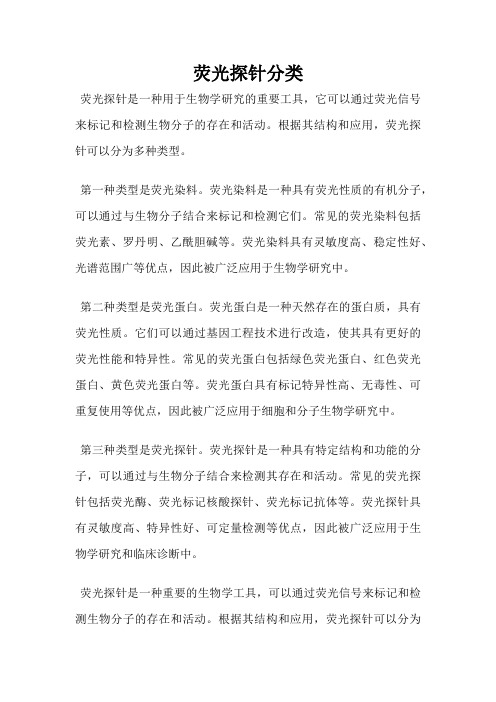
荧光探针分类
荧光探针是一种用于生物学研究的重要工具,它可以通过荧光信号来标记和检测生物分子的存在和活动。
根据其结构和应用,荧光探针可以分为多种类型。
第一种类型是荧光染料。
荧光染料是一种具有荧光性质的有机分子,可以通过与生物分子结合来标记和检测它们。
常见的荧光染料包括荧光素、罗丹明、乙酰胆碱等。
荧光染料具有灵敏度高、稳定性好、光谱范围广等优点,因此被广泛应用于生物学研究中。
第二种类型是荧光蛋白。
荧光蛋白是一种天然存在的蛋白质,具有荧光性质。
它们可以通过基因工程技术进行改造,使其具有更好的荧光性能和特异性。
常见的荧光蛋白包括绿色荧光蛋白、红色荧光蛋白、黄色荧光蛋白等。
荧光蛋白具有标记特异性高、无毒性、可重复使用等优点,因此被广泛应用于细胞和分子生物学研究中。
第三种类型是荧光探针。
荧光探针是一种具有特定结构和功能的分子,可以通过与生物分子结合来检测其存在和活动。
常见的荧光探针包括荧光酶、荧光标记核酸探针、荧光标记抗体等。
荧光探针具有灵敏度高、特异性好、可定量检测等优点,因此被广泛应用于生物学研究和临床诊断中。
荧光探针是一种重要的生物学工具,可以通过荧光信号来标记和检测生物分子的存在和活动。
根据其结构和应用,荧光探针可以分为
荧光染料、荧光蛋白和荧光探针三种类型。
不同类型的荧光探针具有不同的优点和适用范围,研究人员可以根据实际需要选择合适的荧光探针进行研究。
药物化学中的荧光探针研究
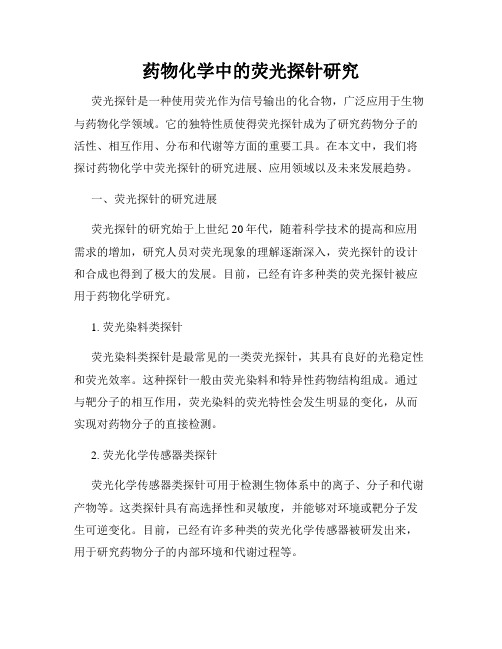
药物化学中的荧光探针研究荧光探针是一种使用荧光作为信号输出的化合物,广泛应用于生物与药物化学领域。
它的独特性质使得荧光探针成为了研究药物分子的活性、相互作用、分布和代谢等方面的重要工具。
在本文中,我们将探讨药物化学中荧光探针的研究进展、应用领域以及未来发展趋势。
一、荧光探针的研究进展荧光探针的研究始于上世纪20年代,随着科学技术的提高和应用需求的增加,研究人员对荧光现象的理解逐渐深入,荧光探针的设计和合成也得到了极大的发展。
目前,已经有许多种类的荧光探针被应用于药物化学研究。
1. 荧光染料类探针荧光染料类探针是最常见的一类荧光探针,其具有良好的光稳定性和荧光效率。
这种探针一般由荧光染料和特异性药物结构组成。
通过与靶分子的相互作用,荧光染料的荧光特性会发生明显的变化,从而实现对药物分子的直接检测。
2. 荧光化学传感器类探针荧光化学传感器类探针可用于检测生物体系中的离子、分子和代谢产物等。
这类探针具有高选择性和灵敏度,并能够对环境或靶分子发生可逆变化。
目前,已经有许多种类的荧光化学传感器被研发出来,用于研究药物分子的内部环境和代谢过程等。
3. 荧光蛋白类探针荧光蛋白类探针是一种利用荧光蛋白家族中的成员作为荧光标记物质的探针。
这类探针具有优异的光稳定性和荧光效率,且能够在活细胞内稳定地发光。
荧光蛋白类探针的研究不仅可以实现对药物分子在细胞水平的观察,还可以用于药物靶点的筛选和药物疗效的评价等。
二、荧光探针的应用领域荧光探针作为一种功能性化合物,已经在药物化学研究中得到了广泛的应用。
1. 药物分子活性研究通过设计和合成荧光探针,可以实现对药物分子的活性进行快速、高通量的筛选和评价。
荧光探针可以直接与靶分子相互作用,通过观察其荧光变化来获取药物分子的活性信息。
这种方法在新药研发和药物结构优化中具有重要意义。
2. 药物相互作用研究荧光探针可以用作药物相互作用的标志物,用于研究药物分子与靶分子之间的结合过程。
常见荧光探针标记的扁豆凝集素辣根过氧化物酶标记的刀豆凝集素(HRP-ConA)

常见荧光探针标记的扁豆凝集素辣根过氧化物酶标记的刀豆凝集素(HRP-ConA)常见荧光探针标记的扁豆凝集素/辣根过氧化物酶标记的刀豆凝集素(HRP-ConA)凝集素的应用前景凝集素的特殊的生物学功能,使其具有广泛的利用前景。
特别是随着生物工程的研究手段和研究领域的不断扩大,凝集素的各种实际应用也展现了新的途径。
凝集素在生命机体中识别外来物,在体内<外)起调理作用。
因此它在认识和解决集约化、半集约化的养殖生物的防病治病中有重要作用。
对凝集素认识的普及和研究的深入将提高我国养殖业总体水平。
对凝集素开发、利用和生化工程技术的拓展,将会使养殖业及其病害防治转化为高技术类型。
凝集素的防卫作用可应用于抗虫基因工程,为抗虫育种提供新的途径。
雪花莲外源凝集素(GNA)对某些咀嚼式和刺吸式昆虫均有抗性,如烟草夜蛾、豇豆象、飞虱、叶蝉和蚜虫,但对高等动物没有毒性。
将编码雪花莲外源凝集素成熟蛋白的eDNA GNA 12和其前体蛋白eDNA GNA 34插入到二元载体pBin438的双倍增强子CaM V 35S启动子或二元载体pBcop l的CoYMV启动子下游,分别构建成植物表达载体pBGnal2、pBGna34、pBCGnal2和pBCGna34。
凝集素由于能和糖专一性识别,而且糖的专一性范围又广,加上易于分离纯化,所以经常作为免疫学和糖生物学的分子探针,对生理、生化过程进行研究。
先用标记物将凝集素标记,再利用标记的凝集素来研究糖复合物的结构、在生物体内的分布,也可用于研究生理、病理过程。
比如研究精子在与卵子结合过程中,其细胞表面受体的种类和分布的变化:研究细胞分化发育过程中,糖结构发生的变化和蛋白质糖基化;恶性病变细胞表面糖类结构变化及转移过程中糖类结构特征等等。
由于凝集素可与糖分子专一性可逆结合,从而被广泛用于分离纯化糖分子、糖蛋白、糖脂。
利用凝集素分离糖蛋白开始于ConA分离酵母蔗糖酶。
现在已有商品化的ConA、扁豆凝集素、PNA等亲合层析柱出售。
荧光探针
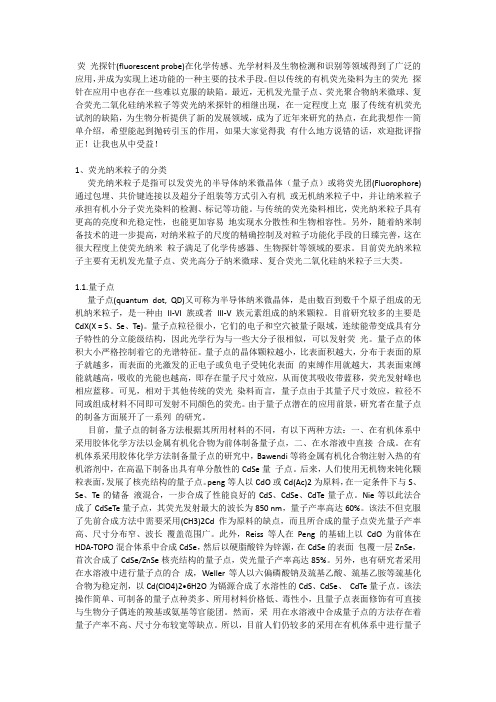
荧光探针(fluorescent probe)在化学传感、光学材料及生物检测和识别等领域得到了广泛的应用,并成为实现上述功能的一种主要的技术手段。
但以传统的有机荧光染料为主的荧光探针在应用中也存在一些难以克服的缺陷。
最近,无机发光量子点、荧光聚合物纳米微球、复合荧光二氧化硅纳米粒子等荧光纳米探针的相继出现,在一定程度上克服了传统有机荧光试剂的缺陷,为生物分析提供了新的发展领域,成为了近年来研究的热点,在此我想作一简单介绍,希望能起到抛砖引玉的作用,如果大家觉得我有什么地方说错的话,欢迎批评指正!让我也从中受益!1、荧光纳米粒子的分类荧光纳米粒子是指可以发荧光的半导体纳米微晶体(量子点)或将荧光团(Fluorophore)通过包埋、共价键连接以及超分子组装等方式引入有机或无机纳米粒子中,并让纳米粒子承担有机小分子荧光染料的检测、标记等功能。
与传统的荧光染料相比,荧光纳米粒子具有更高的亮度和光稳定性,也能更加容易地实现水分散性和生物相容性。
另外,随着纳米制备技术的进一步提高,对纳米粒子的尺度的精确控制及对粒子功能化手段的日臻完善,这在很大程度上使荧光纳米粒子满足了化学传感器、生物探针等领域的要求。
目前荧光纳米粒子主要有无机发光量子点、荧光高分子纳米微球、复合荧光二氧化硅纳米粒子三大类。
1.1.量子点量子点(quantum dot, QD)又可称为半导体纳米微晶体,是由数百到数千个原子组成的无机纳米粒子,是一种由II-VI 族或者III-V 族元素组成的纳米颗粒。
目前研究较多的主要是CdX(X = S、Se、Te)。
量子点粒径很小,它们的电子和空穴被量子限域,连续能带变成具有分子特性的分立能级结构,因此光学行为与一些大分子很相似,可以发射荧光。
量子点的体积大小严格控制着它的光谱特征。
量子点的晶体颗粒越小,比表面积越大,分布于表面的原子就越多,而表面的光激发的正电子或负电子受钝化表面的束缚作用就越大,其表面束缚能就越高,吸收的光能也越高,即存在量子尺寸效应,从而使其吸收带蓝移,荧光发射峰也相应蓝移。
pcr荧光探针的种类
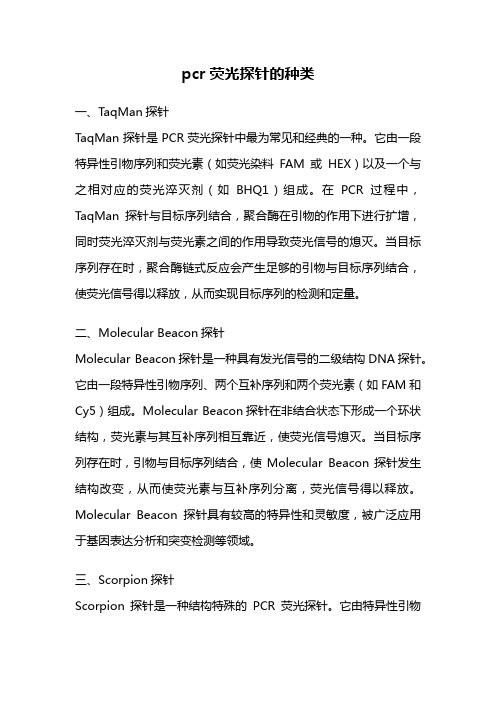
pcr荧光探针的种类一、TaqMan探针TaqMan探针是PCR荧光探针中最为常见和经典的一种。
它由一段特异性引物序列和荧光素(如荧光染料FAM或HEX)以及一个与之相对应的荧光淬灭剂(如BHQ1)组成。
在PCR过程中,TaqMan探针与目标序列结合,聚合酶在引物的作用下进行扩增,同时荧光淬灭剂与荧光素之间的作用导致荧光信号的熄灭。
当目标序列存在时,聚合酶链式反应会产生足够的引物与目标序列结合,使荧光信号得以释放,从而实现目标序列的检测和定量。
二、Molecular Beacon探针Molecular Beacon探针是一种具有发光信号的二级结构DNA探针。
它由一段特异性引物序列、两个互补序列和两个荧光素(如FAM和Cy5)组成。
Molecular Beacon探针在非结合状态下形成一个环状结构,荧光素与其互补序列相互靠近,使荧光信号熄灭。
当目标序列存在时,引物与目标序列结合,使Molecular Beacon探针发生结构改变,从而使荧光素与互补序列分离,荧光信号得以释放。
Molecular Beacon探针具有较高的特异性和灵敏度,被广泛应用于基因表达分析和突变检测等领域。
三、Scorpion探针Scorpion探针是一种结构特殊的PCR荧光探针。
它由特异性引物序列、荧光素(如FAM)和荧光淬灭剂(如BHQ1)组成。
Scorpion探针在非结合状态下形成一个环状结构,荧光淬灭剂与荧光素之间的作用导致荧光信号熄灭。
当目标序列存在时,引物与目标序列结合,使Scorpion探针发生结构改变,从而使荧光淬灭剂与荧光素分离,荧光信号得以释放。
Scorpion探针具有较高的特异性和灵敏度,广泛应用于基因表达和突变分析等领域。
四、SYBR Green探针SYBR Green探针是一种与DNA结合并发出荧光信号的染料。
它能与所有PCR扩增产物结合,因此不需要设计特异性引物。
在PCR 过程中,SYBR Green与扩增产物结合,发出荧光信号。
化学荧光探针

化学荧光探针荧光探针是一种在化学和生物学领域中被广泛使用的重要工具,它可以通过特定的化学反应或分子结构发出荧光信号,用于检测、分析和研究目标物质的性质和活性。
荧光探针具有高选择性、高灵敏度和非破坏性等优点,被广泛应用于生物传感、药物筛选、环境监测以及材料科学等领域。
本文将介绍化学荧光探针的基本原理、应用以及未来发展方向。
一、荧光探针的基本原理荧光探针的发光原理主要涉及激发态和基态之间的能量转移。
当荧光探针被激发时,其电子跃迁至激发态,随后通过无辐射能量转移过程回到基态,并放出荧光光子。
这一过程中,荧光探针的发光强度和光谱特性与所作用的目标物质密切相关,因此可以通过测量荧光信号来分析和检测目标物质。
荧光探针的选择取决于目标物质的特性和所需的检测方法。
例如,针对生物体内的特定分子或离子,可以设计针对性的荧光探针来实现高选择性的检测。
常见的荧光探针包括有机染料、量子点、金纳米粒子等。
这些探针通过特定的化学反应或分子结构来实现针对性的检测和分析。
二、荧光探针的应用1. 生物传感生物传感是荧光探针应用的重要领域之一。
通过选择合适的荧光探针,可以实现对细胞、蛋白质、核酸等生物分子的高灵敏度检测。
例如,荧光蛋白作为生物标记物具有广泛的应用前景,可以在免疫组织化学、蛋白质定位、基因表达等方面发挥重要作用。
2. 药物筛选荧光探针在药物筛选中也发挥着重要的作用。
通过设计合适的荧光探针,可以实现对药物分子与靶标分子之间相互作用的快速检测和定量分析。
这不仅可以提高药物筛选的效率,还可以降低筛选成本。
3. 环境监测化学荧光探针在环境监测领域中的应用也越来越广泛。
例如,荧光探针可以用于检测水中重金属离子的含量,实现对环境污染的快速监测和预警。
此外,荧光探针还可以用于检测空气中的有害气体、土壤中的有机物等,为环境保护提供重要的技术支持。
三、化学荧光探针的未来发展方向随着科学技术的不断发展,荧光探针的种类和性能将继续得到改善和扩展。
医学检测中的荧光探针技术

医学检测中的荧光探针技术在当今的医学领域,荧光探针技术是一种前沿的检测手段,它应用了现代化学、物理、生物学、生物医学工程学等多个领域的技术知识。
荧光探针技术通过特定的分子结构设计和化学修饰,使靶分子与探针结合后发生荧光变化,通过检测这一变化来识别分子,进而实现定量检测和显微成像。
荧光探针技术在分子诊断、药物筛选、分子分析等多个领域均有广泛应用。
一、荧光探针技术的原理及分类荧光探针技术是一种基于光谱学的分析技术。
其原理是在特定的波长激发下,荧光物质会发生能级上的跃迁,发射出从紫外光到可见光的一系列波长的荧光辐射。
荧光强度与溶液中荧光物质的浓度相关,因此可以利用荧光信号强度来定量检测所需分析物的浓度。
荧光探针技术根据探针与样品之间的相互作用类型,主要分为竞争性探针和非竞争性探针两种。
竞争性探针顾名思义就是多种荧光探针将竞争性分别与待测物质结合,产生不同的荧光信号,进而用以鉴定检测物质浓度和种类。
非竞争性探针则通过与样品中的特定分子相互作用来发射荧光信号,例如分子靶向荧光探针用于实现细胞成像、病理组织分析等。
二、荧光探针技术在医学检测中的应用1. 分子诊断荧光探针技术在分子诊断中的应用主要集中于基因检测和蛋白质组诊断。
基因检测中,荧光标记可以用于实时PCR技术中,对目标mRNA进行快速分析;在蛋白质组诊断中,利用荧光探针可以实现高通量分析,帮助专家快速发现疾病标志物,如癌症的特异性分子。
2. 病理组织分析荧光探针技术还可以应用于病理组织分析中。
在高通量细胞成像和分析中,利用荧光标记在特定细胞或组织中进行标记和分析,可以快速、精准地分析细胞起始、分化转化、异常变形、细胞死亡的变化过程,从而分析出病理变化的相关标志物。
3. 药物和生物分析荧光探针技术还可以应用于生物和药物分析中。
例如,荧光探针可以与生物大分子或小分子结合,依赖荧光强度来检测受体配体、路径选择、酶催化、蛋白质-蛋白质相互作用等过程,从而检验药物效果、药物活性、细胞生理功能等。
荧光探针概述范文

荧光探针概述范文荧光探针是一种用于检测和观察特定生物分子或细胞结构的工具。
它们基于荧光现象,通过发光来标记和定位目标物质。
荧光探针在生物科学研究、医学诊断和药物研发等领域具有广泛的应用,被广泛用于细胞成像、分子探测和生物分析等方面。
荧光探针的原理是利用发光分子在受激发后发出可见光的特性。
其结构基本上由以下几个部分组成:荧光基团、连接基团和靶向基团。
荧光基团是发光的核心部分,可以利用化学反应或物理效应来实现发光。
连接基团用于将荧光基团与靶向基团连接起来,使荧光基团能够与目标物质结合。
靶向基团是指与目标物质具有亲和性的分子,通过与目标物质的相互作用,使荧光探针能够准确地定位和检测目标物质。
荧光探针的选择取决于具体的研究目标。
常见的荧光探针包括有机染料、荧光蛋白和量子点等。
有机染料是最常用的荧光探针,其发光波长可以调节,适用于不同的研究需求。
荧光蛋白是从动物或细菌中提取的天然荧光标记物质,具有广泛的应用前景。
量子点是一种由半导体纳米颗粒组成的荧光探针,具有较高的亮度和稳定性,适用于高灵敏度的荧光成像。
荧光探针的应用涵盖了多个领域。
在细胞成像方面,荧光探针可以在细胞水平上观察到特定的分子分布和相互作用,帮助揭示细胞的结构和功能。
例如,荧光探针可以用于跟踪细胞内特定的蛋白质、核酸或小分子,研究其在细胞中的运动和相互作用。
在药物研发中,荧光探针可以用于筛选和评估候选药物分子对目标分子的亲和力和特异性。
此外,荧光探针还可以用于环境监测、食品安全和生物传感等领域。
荧光探针的设计和合成是一个多学科交叉的研究领域。
研究人员需要综合考虑探针的亮度、稳定性、选择性和毒性等因素,并根据具体的研究目标进行合理的设计。
同时,还需要利用化学合成和材料科学等技术手段来合成和制备高性能的荧光探针。
此外,荧光探针的成像和分析方法也需要不断地发展和改进,以提高其灵敏度和分辨率。
总之,荧光探针是一种重要的生物标记工具,具有广泛的应用前景。
荧光探针在医学检测中的应用
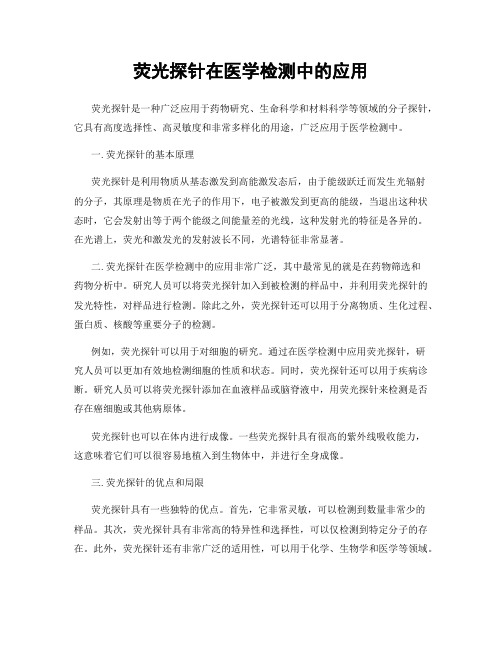
荧光探针在医学检测中的应用荧光探针是一种广泛应用于药物研究、生命科学和材料科学等领域的分子探针,它具有高度选择性、高灵敏度和非常多样化的用途,广泛应用于医学检测中。
一. 荧光探针的基本原理荧光探针是利用物质从基态激发到高能激发态后,由于能级跃迁而发生光辐射的分子,其原理是物质在光子的作用下,电子被激发到更高的能级,当退出这种状态时,它会发射出等于两个能级之间能量差的光线,这种发射光的特征是各异的。
在光谱上,荧光和激发光的发射波长不同,光谱特征非常显著。
二. 荧光探针在医学检测中的应用非常广泛,其中最常见的就是在药物筛选和药物分析中。
研究人员可以将荧光探针加入到被检测的样品中,并利用荧光探针的发光特性,对样品进行检测。
除此之外,荧光探针还可以用于分离物质、生化过程、蛋白质、核酸等重要分子的检测。
例如,荧光探针可以用于对细胞的研究。
通过在医学检测中应用荧光探针,研究人员可以更加有效地检测细胞的性质和状态。
同时,荧光探针还可以用于疾病诊断。
研究人员可以将荧光探针添加在血液样品或脑脊液中,用荧光探针来检测是否存在癌细胞或其他病原体。
荧光探针也可以在体内进行成像。
一些荧光探针具有很高的紫外线吸收能力,这意味着它们可以很容易地植入到生物体中,并进行全身成像。
三. 荧光探针的优点和局限荧光探针具有一些独特的优点。
首先,它非常灵敏,可以检测到数量非常少的样品。
其次,荧光探针具有非常高的特异性和选择性,可以仅检测到特定分子的存在。
此外,荧光探针还有非常广泛的适用性,可以用于化学、生物学和医学等领域。
但是,荧光探针也有其局限性。
首先,荧光探针有时会被其他分子所遮蔽,从而影响其检测灵敏度。
此外,荧光探针需要较高的灯光亮度和放大倍数才能有效工作,这需要相对昂贵的仪器和设备。
四. 结论总体来说,荧光探针在医学检测中的应用非常广泛,具有非常广阔的前景。
荧光探针在医学检测和药物辅助研究中,将会起到非常重要的作用。
近年来,随着荧光探针技术的不断发展和完善,荧光探针在药物研究和医学检测中的应用将会更加广泛和深入。
荧光探针在化学分析中的应用研究

荧光探针在化学分析中的应用研究荧光探针是一种用于分子识别和检测的化学工具,其基本原理是分子与荧光物质相互作用,从而产生荧光信号。
在绿色环保的化学分析中,荧光探针已经成为一种重要的分析手段。
本文将探讨荧光探针的基本原理、常见应用及相关研究。
一、荧光探针的基本原理荧光探针是一种能够发射荧光信号的分子,其原理与分子内能量转移和荧光共振能量转移(FRET)有关。
荧光探针包括一个荧光物质和一个识别结构,荧光物质的主要功能是发射荧光信号,而识别结构的功能是与待测分子结合,并改变荧光物质的发射特性。
可以根据待测分子的性质选择对应的荧光探针,从而实现对待测分子的高效准确检测。
二、荧光探针在化学分析中的应用荧光探针广泛用于化学分析中,其应用领域包括生物医学、环境与食品分析、生命科学和化学工业等。
1.生物医学应用荧光探针在生物医学领域中最为广泛应用,在分子诊断、药物发现和生物遗传学等方面发挥着巨大作用。
荧光探针可以用于分析生物样品如血液、组织和尿液等,也可用于细胞和组织的成像。
2.环境与食品分析荧光探针在环境和食品分析中也得到广泛应用。
例如,开发了一种基于荧光探针的气相色谱法,用于检测食品中的有害物质如塑化剂和污染物等。
此外,荧光探针还可用于环境水质检测,如检测污染物、重金属和水中微生物等。
3.生命科学应用荧光探针在生命科学领域中也有广泛应用,如分析细胞通讯、基因表达和蛋白质相互作用等。
例如,用于检测DNA的荧光探针可用于评估DNA损伤和细胞凋亡等。
4.化学工业应用荧光探针在化工领域中也有应用,如用于辅助化学反应的跟踪、污染物的检测等。
例如,荧光探针可用于监测催化剂的状态,以提高化学反应的效率。
三、荧光探针的相关研究随着科学技术的不断发展,荧光探针的相关研究也在不断进展。
以下几个方面是当前较有研究价值的领域:1.荧光探针的设计与合成荧光探针的设计和合成是荧光探针研究中的基础。
在荧光探针的设计和合成中,需要充分考虑分子的相互作用如静电作用、氢键作用和金属配位等,以提高荧光探针的检测灵敏度和特异性。
利用荧光探针技术分析细胞和组织的功能

利用荧光探针技术分析细胞和组织的功能荧光探针技术是一种广泛应用于生物医学领域的分析技术,它可以用来研究生物分子、细胞和组织的结构和功能特征。
在现代医学中,荧光探针技术被广泛用于诊断疾病、药物筛选和研究细胞和分子的生理过程。
在本文中,我们将探讨利用荧光探针技术分析细胞和组织的功能的相关内容。
细胞和组织是人体内最基本的生物结构,它们的正常功能对于维持人体的健康和正常发育有着至关重要的作用。
荧光探针技术可以用来研究细胞和组织的基本物理和化学特性、分子结构、代谢过程和信号传递机制等方面,它的应用范围非常广泛。
荧光探针技术有很多种,其中最常见的是荧光染料。
荧光染料大多是性质稳定、光稳定和水溶性的化合物,它们可以通过荧光显微镜等设备对细胞进行标记和成像。
荧光探针技术通常会在细胞或组织标记处产生明亮的发光,这种发光会发出特定的波长和颜色,因此可以用来定量分析细胞和组织的分子、蛋白质和代谢产物等信息。
荧光探针技术的另一个重要应用是在细胞信号传递和蛋白质相互作用等领域。
比如,在细胞信号传递中,荧光探针技术可以用来追踪特定的分子和信号转导途径,这对于了解细胞内信号传递的机制和调节非常重要。
在蛋白质相互作用中,荧光探针技术可以用来研究蛋白质的结构和功能特征,进而揭示蛋白质的生理过程和疾病机理。
除了荧光染料之外,还有一些其他的荧光探针技术可以用来研究细胞和组织的功能。
例如,荧光共振能量转移技术(FRET)可以用来研究细胞内分子间的相互作用关系,这种技术可以用来定量分析蛋白质相互作用和酶活性等信息。
另外,单分子荧光显微镜技术也是一种非常有前途的技术,它可以用来研究细胞内小分子、蛋白质和活性酶等分子的运动和结构特征。
总的来说,荧光探针技术是一种非常有前途和应用潜力的技术,在生物医学研究和临床诊断中有着非常广泛的应用。
随着生物医学领域的不断发展和进步,荧光探针技术必将在细胞和组织的功能分析、药物筛选和疾病诊断等方面发挥越来越重要的作用。
常用荧光探针小结
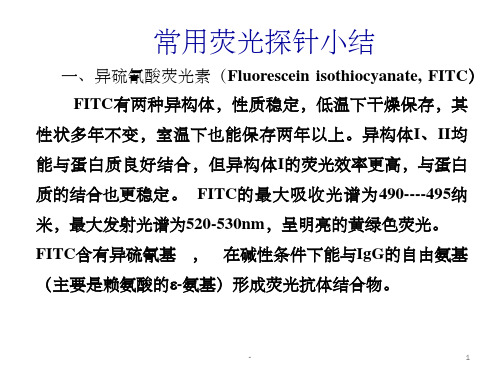
-
11
DAPI (magenta) bound to the minor groove of DNA (green and blue).
DAPI can be used for fixed cell staining, the concentration of DAPI needed for live cell staining is generally very high and rarely used for live cells. Though it was not shown to have mutagenicity to E. coli, it is labelled as a known mutagen in manufacturer information. As it is a DNA binding compound it is likely to have some low level mutagenic properties and care should be taken in its handling and disposal.
-
1
Exitation λmax: 495 nm; Emission λmax: 519 nm; Solvent pH:8.00
-
2
Immunocytochemistry/Immunofluorescence-alpha Tubulin antibody [DM1A] (FITC) (ab64503)
ac413230010rb200也称丽丝胺罗丹明b无定形褐红色粉末不溶于水易溶于酒精和丙酮性质稳定可长期保存最大吸收光谱为570nm呈明亮的橙色荧光因与fitc的黄绿色有明显区别故被广泛用于对比染色或用于两种不同颜色的荧光抗体的双重染色
化学中的荧光探针研究

化学中的荧光探针研究化学中的荧光探针是一种在化学分析、生物医学和生命科学领域中广泛使用的工具。
它通过光激发荧光信号来探测物质的存在和状态,因此被广泛用于光学传感和成像。
荧光探针的光谱性质和性能是荧光探针研究的重要方面。
光谱性质包括荧光光谱,吸收光谱和激光诱导荧光光谱,这些光谱可以用来判断荧光探针在光激发下的表现和响应情况。
另外荧光探针的光稳定性,相对量子产率和荧光寿命等也是关键的性能指标。
荧光探针的设计和合成需要充分考虑其对待测物质的选择性和灵敏度。
因此,在荧光探针研究中,选择一个适当的化学结构和功能基团对于实现该目标是至关重要的。
此外,荧光探针还需要调整它的光谱性质和性能,以满足不同的应用需求。
荧光探针在生命科学和生物医学领域的应用尤其重要。
例如,荧光探针可用于分离、分析和排序细胞,并诊断疾病如肿瘤。
此外,荧光探针也用于检测细胞内小分子的活动和生物分子的交互作用。
因为荧光探针具有非侵入性和非破坏性的特点,所以它是生命科学和生物医学领域内非常有前景的工具。
现在,越来越多的研究人员开始将荧光探针应用于环境污染和化学安全监测。
例如,在水中检测重金属离子和有机物,这样的荧光探针可以用于水处理和饮用水安全监测。
同时,在有机物和化学品的检测中,荧光探针可以提供一种快速、准确和经济的分析方法。
总之,荧光探针是一种在不同领域中广泛应用的分析工具。
荧光探针研究的目标是开发高效稳定、可选择性和高灵敏度的探针。
荧光探针在生物医学,生态环境,化学分析以及工业领域都有广泛的应用。
随着人们对荧光探针研究的深入,我们相信它将会有更多的应用和科研价值的发掘。
生物分子的荧光探针应用研究

生物分子的荧光探针应用研究生物分子的荧光探针是一种广泛应用于生物学、生物医学和生化分析等领域的研究工具。
它可以通过特定的化学反应和生物学过程,用荧光信号监测和分析复杂的生物分子、细胞和组织的结构、功能和相互作用,具有高度的选择性、敏感性和分辨率,成为生命科学研究中不可或缺的技术手段。
1. 荧光探针的基本原理荧光是一种从激发态分子返回到基态时放出的能量。
荧光探针的基本原理是将荧光基团引入到生物分子中,通过分子内或分子间的相互作用改变荧光强度、波长或寿命,从而实现对生物分子的检测和分析。
常用的荧光探针包括荧光蛋白、荧光染料、荧光标记的核酸、蛋白质和酶等,它们的荧光信号可以通过激发、放射、荧光共振能量传递、荧光共振能量转移、荧光猝灭和荧光旋转解析等方式进行检测。
2. 荧光探针在生物学中的应用荧光探针在生物学中有着广泛的应用,主要包括:2.1. 生物成像荧光探针可以应用于细胞和组织的三维成像,例如通过用荧光标记的抗体对细胞表面标志物进行染色,使用荧光显微镜和荧光探针观察和分析细胞内分子和结构的位置、分布和相互作用。
还可以通过活体荧光成像技术,实现对动植物的非侵入式活体成像和监测,以及对疾病的早期诊断和治疗的研究和开发。
2.2. 生物传感荧光探针可以应用于生物传感,例如测量分子浓度、结构和功能的变化。
通过荧光共振能量转移或荧光猝灭等机制,可以实现对蛋白质、脱氧核糖核酸(DNA)和核苷酸(RNA)等分子的检测和分析,进而帮助解决癌症、心脑血管疾病等疾病的诊断和治疗问题。
2.3. 生物分析荧光探针可以应用于生物分析,例如通过荧光共振能量传递或荧光旋转解析技术,实现对酶的活性和抑制剂的筛选,或者确定蛋白质和核酸的三维结构和功能等。
3. 荧光探针的应用示例3.1. GFP基因重组技术绿色荧光蛋白(GFP)是一种具有原代荧光性质的蛋白质,其发现和研究极大地推动了生物学和生物医学研究的发展。
研究人员可以通过基因重组技术,将GFP基因与其他感兴趣的蛋白质基因组成融合蛋白,从而实现对该蛋白质在细胞和组织中的位置和运动的实时观察和分析,成为生物分子荧光探针应用中的一个典型例子。
- 1、下载文档前请自行甄别文档内容的完整性,平台不提供额外的编辑、内容补充、找答案等附加服务。
- 2、"仅部分预览"的文档,不可在线预览部分如存在完整性等问题,可反馈申请退款(可完整预览的文档不适用该条件!)。
- 3、如文档侵犯您的权益,请联系客服反馈,我们会尽快为您处理(人工客服工作时间:9:00-18:30)。
七、Hoechst
Hoechst stains are part of a family of blue fluorescent dyes used to stain DNA. These Bis-benzimides were originally developed by Hoechst AG. There are three related Hoechst stains: Hoechst 33258, Hoechst 33342, and Hoechst 34580. The dyes Hoechst 33258 and Hoechst 33342 are the ones most commonly used and they have similar excitation/emission spectra.
11
DAPI (magenta) bound to the minor groove of DNA (green and blue).
DAPI can be used for fixed cell staining, the concentration of DAPI needed for live cell staining is generally very high and rarely used for live cells. Though it was not shown to have mutagenicity to E. coli, it is labelled as a known mutagen in manufacturer information. As it is a DNA binding compound it is likely to have some low level mutagenic properties and care should be taken in its handling and disposal.
ICC/IF image of ab64503 stained human HeLa cells. The cells were methanol fixed (10 min), permabilised in 0.1% PBS-Tween (20 min) and incubated with the antibody (ab64503, 1µg/ml, FITC conjugated (green)) for 1h at room temperature. 1% BSA / 10% normal goat serum / 0.3M glycine was used to block non-specific protein-protein interactions. Alexa Fluor® 594 WGA was used to label plasma membranes (red). DAPI was used to stain the cell nuclei (blue).
13
Endothelial cells under the microscope. Nuclei are stained blue with DAPI, microtubles are marked green by an antibody and actin filaments are labelled red with phalloidin.
DAPI is a dye which binds to DNA and shows an increased blue fluorescence when bound to DNA. The blue fluorescent spots in the picture show the nuclei in the mycel.
12
A type of simple fluorescence: DAPI is excited in near UV with 365 nm and emitted in the violet-blue spectral range. The marking reveals cell nuclei and particularly the chromosomes
17
八、碘化丙啶(Propidium Iodide, PI)
PI
EB
Propidium iodide is an intercalating agent and a fluorescent molecule that can be used to stain cells. When PI is bound to nucleic acids, the fluorescence excitation maximum is 535 nm and the emission maximum is 617 nm. Excitation energy can be supplied with a xenon or mercury-arc lamp or with the 488 line of an argon-ion laser. Propidium iodide is used as a DNA stain for both flow cytometry, to evaluate cell viability or DNA content in cell cycle analysis, and microscopy to visualise the nucleus and other DNA containing organelles. It can be used to differentiate necrotic, apoptotic and normal cells.
6
Detection of α-tubulin in A549 cells demonstrates use of rhodamine-labeled secondary antibody. Cells were probed with a mouse anti-α-tubulin primary antibody (0.4µg/mL) and Rhodamine-goat anti-mouse secondary antibody (2µg/mL). Nuclei were labeled with Hoechst Dye. Images were acquired by fluorescence microscopy. A. Fluorescence image shows a delicate network of α-tubulin (pseudo-colored green) located exclusively in the cytoplasm. B. Nuclear counterstain with Hoechst Dye (pseudo-colored blue) C. Merged image.
7
四、罗丹明200
AC41323-0010
RB200,也称丽丝胺罗丹明B 无定形褐红色粉末,不溶于水,易溶于酒精 和丙酮,性质稳定,可长期保存,最大吸收光谱为570nm,呈明亮的橙色荧 光,因与FITC的黄绿色有明显区别,故被广泛用于对比染色或用于两种不同 颜色的荧光抗体的双重染色。
标 记 方 法 方法:取1g RB200及五氯化磷(PCL5)2g放乳钵中研磨5min (在毒气操作橱中),加10ml无水丙酮,放置5min,随时搅拌,过滤,用所 得溶液进行结合。将每亳升血清用1ml生理盐水及1ml碳酸盐缓冲液 (0.5mol/L,pH9.5)稀释,逐滴加入0.1ml RB200溶液,随加随搅拌,在04℃继续搅拌 12-18h。
9
五、溴化乙锭
详见第四节“应用于核酸检测的荧光探针技术”
10
六、DAPI ( 4‘,6-diamidino-2-phenylindole)
DAPI was first synthesised in as part of a search for drugs to treat trypanosomiasis. Although it was unsuccessful as a drug, further investigation indicated it bound strongly to DNA and became more fluorescent when bound. When bound to double-stranded DNA DAPI has an absorption maximum at a wavelength of 358 nm (ultraviolet) and its emission maximum is at 461 nm (blue). Therefore for fluorescence microscopy DAPI is excited with ultraviolet light and is detected through a blue/cyan filter. The emission peak is fairly broad DAPI will also bind to RNA, though it is not as strongly fluorescent. Its emission shifts to around 500 nm when bound to RNA.
常用荧光探针小结
一、异硫氰酸荧光素(Fluorescein isothiocyanate, FITC) FITC有两种异构体,性质稳定,低温下干燥保存,其
性状多年不变,室温下也能保存两年以上。异构体I、II均 能与蛋白质良好结合,但异构体I的荧光效率更高,与蛋白 质的结合也更稳定。 FITC的最大吸收光谱为490----495纳 米,最大发射光谱为520-530nm,呈明亮的黄绿色荧光。 FITC含有异硫氰基 , 在碱性条件下能与IgG的自由氨基 (主要是赖氨酸的-氨基)形成荧光抗体结合物。
